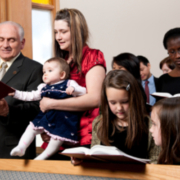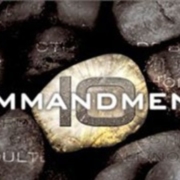What is the Large Catechism?
Condensed TV football games, courtesy of Tivo? Good. (Fast-forward through all those commercials and breaks in action.)
Whole gourmet meals, condensed into a pill? Not good.
Condensed movies— as with a movie trailer? For fans anticipating new flicks? Good.
Condensed marriage vows (“I’ll be faithful, okay?”)? Not good.
Condensed sermons? With Martin Luther’s Large Catechism, good— and much good news for you.
Martin Luther taught at the University of Wittenberg, in northern Germany. He also preached at Wittenberg churches. In 1528 and 1529 Luther preached a series of sermons to teach average adults— children too— what he figured to be the minimum every Christian must believe for life with God now and forever. In short, he condensed the Bible.
Then Luther condensed those sermons into a book, his Large Catechism. He designed it to complement his Small Catechism [link to the other article] While the Small Catechism runs about 20 pages, the Large Catechism is about 140 pages—seven times bigger. (That isn’t large. The Catholic Catechism runs 800+ pages.)
Why learn from a 140 page condensation, if a 20 page ultra-condensation will do? One reason: in the Large Catechism, Luther writes so truthfully and vividly. For example, Luther tells people who don’t feel hunger and thirst for the Lord’s Supper to put their hands to their chest to figure out if they are made of flesh and blood, then read what the Bible says about our sinful flesh.
“Again,” he writes, “look around you and see whether you are also in the world. If you do not know, ask your neighbors about it. If you are in the world, do not think that there will be any lack of sins and needs. […]
“Moreover, you will surely have the devil around you, too. […] If you could see how many daggers, spears, and arrows are aimed at you every moment, you would be glad to come to the sacrament as often as you can.”
Like the Small Catechism, the Large Catechism features:
- Ten Commandments
- The Creed
- The Lord’s Prayer
- Baptism
- The Sacrament [“sacred act”] of the Altar
Don’t think of either catechism like your second-grade math book. Once you passed it, you went on to the third-grade edition. You never needed the former book again, except perhaps to teach math to a child.
Luther did mean both his catechisms to help adults teach the ABCs of God’s holy demands and amazing grace to young people. Luther, though, didn’t think of his catechisms as textbooks to master, then discard. They’re like the owner’s manual for your car, which you should study thoroughly when you begin driving that car, and keep at hand to consult whenever you need a refresher.
Luther went further. To cocky “experts” who thought they had surpassed the condensed basics of his catechisms, Luther wrote in the Large Catechism’s preface: “I am also a doctor [of theology] and a preacher, just as learned and experienced as all of them who are so high and mighty. Nevertheless, each morning, and whenever else I have time, I do as a child who is being taught the catechism and I read and recite word for word the Lord’s Prayer, the Ten Commandments, the Creed, the Psalms, etc. I must still read and study the catechism daily, and yet I cannot master it as I wish, but must remain a child and pupil of the catechism— and I also do so gladly.”
You will too, for Jesus’ sake.
To read the Large Catechism in English, click here.










